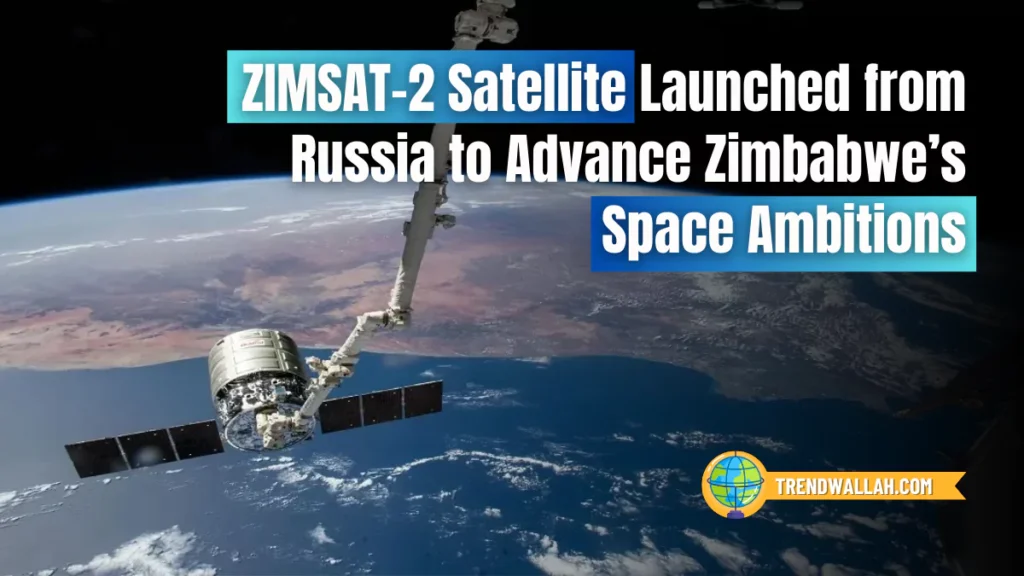
Zimbabwe has successfully launched its second satellite, ZIMSAT-2, from the Vostochny Cosmodrome in Russia. This launch highlights Zimbabwe’s commitment to space technology, building upon the nation’s first satellite launch, ZIMSAT-1, in November 2022. Spearheaded by the Zimbabwe National Geo-Spatial and Space Agency (ZINGSA) in collaboration with Southwest State University (SWSU) in Russia, ZIMSAT-2 aims to support agriculture, resource management, and urban planning.
High-Resolution Imaging for Agriculture and Resource Management
ZIMSAT-2 is equipped with a high-resolution multispectral camera, designed to help Zimbabwean farmers by tracking crop health, identifying nutrient deficiencies, and estimating yields. By using Normalized Difference Vegetation Index (NDVI), ZIMSAT-2 will provide detailed insights into vegetation, enhancing food security through precision agriculture.
Resource Mapping to Support Mining and Economic Development
In addition to agricultural support, ZIMSAT-2’s imaging capabilities will be instrumental for resource mapping. The satellite is expected to locate mineral deposits, aiding Zimbabwe’s expanding mining sector and bolstering economic growth.
Urban Planning and Infrastructure Development
ZIMSAT-2 will also contribute to urban planning by providing data on Zimbabwe’s rapidly urbanizing regions. The satellite’s detailed images of structures, roads, and green areas will assist city planners in managing resources and addressing infrastructure needs.
Upgraded Ground Infrastructure for Enhanced Satellite Operations
To maximize ZIMSAT-2’s capabilities, ZINGSA has upgraded the Mazowe Ground Station, enabling better data management and command capabilities. Scheduled for completion by November 2024, this upgraded infrastructure will support satellite tracking, enhancing Zimbabwe’s space operations.
| Key Details of ZIMSAT-2 Launch | |
| Launch Date | 2024, from Vostochny Cosmodrome, Russia |
| Satellite Type | Earth Observation |
| Collaborating Entities | ZINGSA and SWSU, Russia |
| Primary Missions | Agriculture monitoring, resource mapping, urban planning |
| Ground Station Upgrade | Expected completion by November 2024 |
| Satellite Carrier Rocket | Soyuz-2.1b/Fregat-M Rocket |
ZIMSAT-2 Satellite Summary
- Zimbabwe launched its second satellite, ZIMSAT-2, from Russia, boosting its space program.
- The satellite will support agriculture, resource management, and urban planning.
- High-resolution imaging will assist in monitoring crop health and resource mapping.
- Mazowe Ground Station upgrades will enhance satellite tracking and data processing.
- ZIMSAT-2 highlights Zimbabwe’s continued commitment to technological and economic growth.
Also Read Latest Current Affairs 2024
FAQs on ZIMSAT-2 Satellite
ZIMSAT-2 primarily focuses on agriculture monitoring, resource mapping, and urban planning.
ZIMSAT-2 was launched in 2024 from the Vostochny Cosmodrome in Russia.
The satellite uses high-resolution multispectral imaging to monitor crop health, detect nutrient deficiencies, and estimate yields
The ground station upgrades will improve data handling, tracking, and satellite command capabilities.
Other African countries with space initiatives include Nigeria, South Africa, Ethiopia, Kenya, and Egypt.
The satellite captures detailed images of urban areas, helping city planners manage resources and infrastructure.
ZIMSAT-2 was a joint project between Zimbabwe’s ZINGSA and Russia’s Southwest State University (SWSU)
